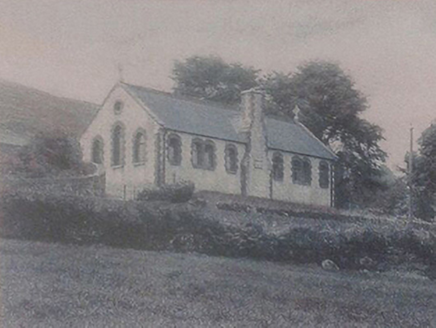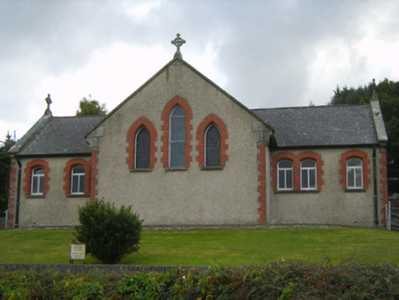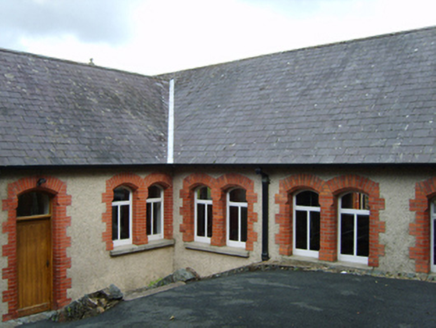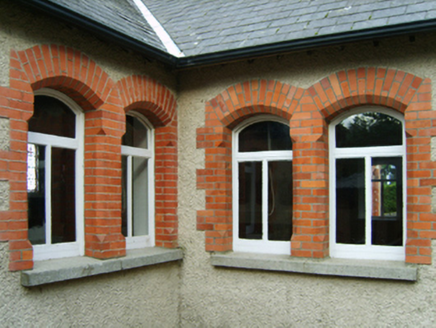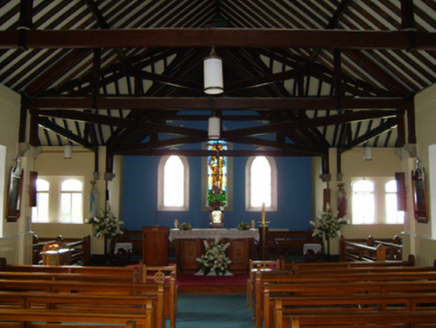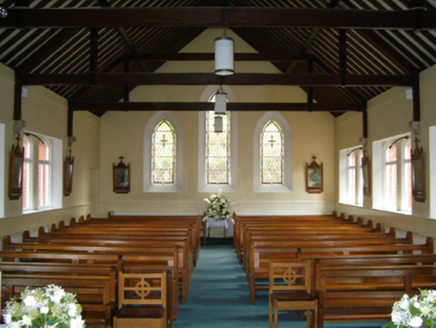Survey Data
Reg No
15700726
Rating
Regional
Categories of Special Interest
Architectural, Artistic, Historical, Social, Technical
Previous Name
Tarahill National School
Original Use
Church/chapel
In Use As
Church/chapel
Date
1925 - 1945
Coordinates
321012, 163031
Date Recorded
27/09/2007
Date Updated
--/--/--
Description
Detached four-bay single-storey Catholic church, built 1939-41; opened 1941, on a cruciform plan comprising two-bay single-storey nave opening into single-bay (two-bay deep) single-storey transepts centred on single-bay single-storey chancel to crossing (north). Renovated, 1987, with sanctuary reordered. Pitched slate roof on a cruciform plan with clay ridge tiles, cut-granite coping to gables on cut-granite "Cavetto" kneelers with Celtic Cross finials to apexes, and cast-iron rainwater goods on exposed timber rafters retaining cast-iron square profile downpipes. Roughcast walls with red brick quoins to corners. Camber-headed window openings centred on paired camber-headed window openings with cut-granite sills, and red brick block-and-start surrounds having chamfered reveals framing timber casement windows. Lancet "Trinity Window" (north) with cut-granite sills, and red brick block-and-start surrounds having chamfered reveals framing fixed-pane fittings having stained glass margins centred on lattice glazing bars. Lancet "Trinity Window" to entrance (south) front with cut-granite sills, and red brick block-and-start surrounds having chamfered reveals framing fixed-pane fittings having stained glass margins centred on lattice glazing bars. Full-height interior open into roof with central aisle between timber pews, Gothic-style timber stations, carpeted stepped dais to sanctuary to crossing (north) reordered, 1987, with timber panelled altar below stained glass "Trinity Window" (1987), and exposed Queen Post timber roof construction on cut-granite "Cavetto" corbels with wind braced rafters to ceiling. Set in landscaped grounds on an elevated site with red brick Flemish bond piers to perimeter having roll moulded gabled capping supporting flat iron gates.
Appraisal
A church erected to a design by Thomas Joseph Cullen (1879-1947) of Suffolk Street, Dublin (de Vál 2004, 80), representing an important component of the twentieth-century built heritage of north County Wexford with the architectural value of the composition, one repurposing a national school erected (1888) to a design by James Joseph McCarthy (1817-82) of Great Brunswick Street [Pearse Street], Dublin (ibid., 80), confirmed by such attributes as the cruciform plan form, aligned along a liturgically-incorrect axis; and the gentle "sweep" of the coupled openings with the chancel defined by a streamlined "Trinity Window". Having been well maintained, the elementary form and massing survive intact together with substantial quantities of the original fabric, both to the exterior and to the interior where an exposed timber roof construction pinpoints the engineering or dexterity of a church making a pleasing visual statement in a rural street scene.
